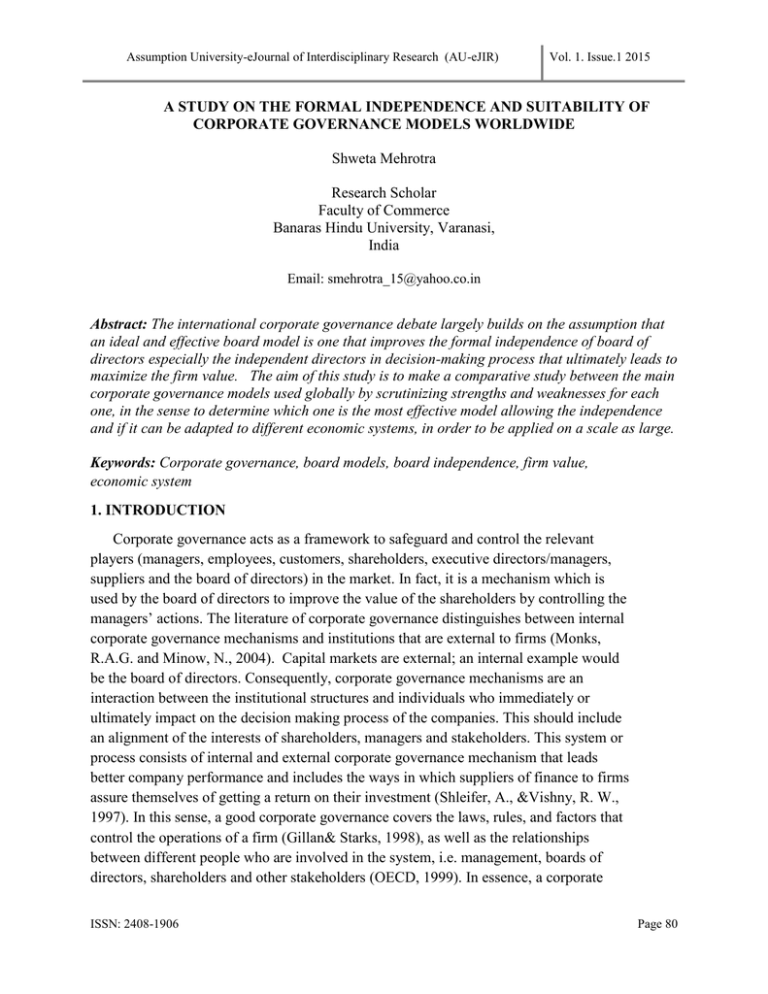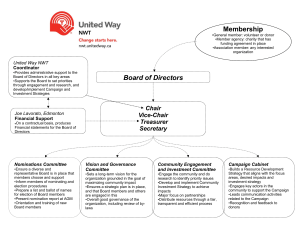WORD - AU EJIR eJournal
advertisement

Assumption University-eJournal of Interdisciplinary Research (AU-eJIR) Vol. 1. Issue.1 2015 A STUDY ON THE FORMAL INDEPENDENCE AND SUITABILITY OF CORPORATE GOVERNANCE MODELS WORLDWIDE Shweta Mehrotra Research Scholar Faculty of Commerce Banaras Hindu University, Varanasi, India Email: smehrotra_15@yahoo.co.in Abstract: The international corporate governance debate largely builds on the assumption that an ideal and effective board model is one that improves the formal independence of board of directors especially the independent directors in decision-making process that ultimately leads to maximize the firm value. The aim of this study is to make a comparative study between the main corporate governance models used globally by scrutinizing strengths and weaknesses for each one, in the sense to determine which one is the most effective model allowing the independence and if it can be adapted to different economic systems, in order to be applied on a scale as large. Keywords: Corporate governance, board models, board independence, firm value, economic system 1. INTRODUCTION Corporate governance acts as a framework to safeguard and control the relevant players (managers, employees, customers, shareholders, executive directors/managers, suppliers and the board of directors) in the market. In fact, it is a mechanism which is used by the board of directors to improve the value of the shareholders by controlling the managers’ actions. The literature of corporate governance distinguishes between internal corporate governance mechanisms and institutions that are external to firms (Monks, R.A.G. and Minow, N., 2004). Capital markets are external; an internal example would be the board of directors. Consequently, corporate governance mechanisms are an interaction between the institutional structures and individuals who immediately or ultimately impact on the decision making process of the companies. This should include an alignment of the interests of shareholders, managers and stakeholders. This system or process consists of internal and external corporate governance mechanism that leads better company performance and includes the ways in which suppliers of finance to firms assure themselves of getting a return on their investment (Shleifer, A., &Vishny, R. W., 1997). In this sense, a good corporate governance covers the laws, rules, and factors that control the operations of a firm (Gillan& Starks, 1998), as well as the relationships between different people who are involved in the system, i.e. management, boards of directors, shareholders and other stakeholders (OECD, 1999). In essence, a corporate ISSN: 2408-1906 Page 80 Assumption University-eJournal of Interdisciplinary Research (AU-eJIR) Vol. 1. Issue.1 2015 governance system provides the structure through which the objectives of the firm are set and the means by which these objectives are attained and monitored. Corporate governance is largely about organisational and management performance. It is about how an organisation is managed, its corporate and other structures, its policies and the ways in which it deals with its various stakeholders. It is concerned with structures and processes for decision making and with control and behaviour that support effective accountability for performance outcomes. Corporate governance is about the system of framework of laws, regulations and institutions with internal and external controls mechanism by which companies are directed and controlled which is based on the principles of integrity, fairness, transparency and accountability. There are various actors involved in corporate governance mechanism in which board of directors holds the apex position in the internal corporate mechanism in aligning the interest of managers and shareholders. A board is consists of executive and non- executive directors including independent directors perceived as a valuable company assets for achieving greater company performance and long- term sustainability of company. “Corporate Governance refers to that blend of law, regulation and appropriate voluntary private sector practices which enables the corporation to attract financial and human capital, perform efficiently and thereby perpetuate itself by generating long term economic value for its shareholders, while respecting the interests of stakeholders and society as a whole” (Ira M. Millstein, 2003, Developing Corporate Governance Codes of Best Practices, Volume I, Global Corporate Governance). Corporate governance structure and model varies significantly among different countries. In a highly dispersed shareholding system, such as is the case in the USA, members of the board of directors are granted the responsibility of monitoring executives. Internal corporate governance systems in Germany and Japan, on the other hand, rest with large shareholders. This is because their business and legal systems allow concentrated and cross shareholdings. The actions of these large shareholders appear to be a combination of aggressively controlling the management as well as a friendly one. Corporate financial managers are expected to act on behalf of shareholders, with the goal of obtaining a reasonable return on their investments. Once the board fails in its duty, share prices would fall and institutional shareholders with a large stake would assume the responsibility of the board of directors. These actions could either be supportive or unfriendly towards the incumbent management team. In widely-held corporations without block holders, the shareholders as principals are protected against wrongdoing by the board through the classic instrument of company law, i.e., duties and liabilities of the directors. In practice, however, the real principal-agent problem in corporations with concentrated ownership is not between the shareholders and the board, but between minority shareholders and the controlling or block holding shareholders. In many countries, for example the United States, Germany, France, the Netherlands and ISSN: 2408-1906 Page 81 Assumption University-eJournal of Interdisciplinary Research (AU-eJIR) Vol. 1. Issue.1 2015 Argentina, shareholder associations play an important role for shareholder protection and for corporate governance in general. In others, like India, Switzerland there is no such kind of associations. 2. BOARD MODELS A comparative approach to the organization of corporate boards gives rise to a number of research questions that are related to the formal independence of one-tier and two-tier boards in Anglo-Saxon and continental European countries. The diversity of board roles in the governance of corporations, differences in the leadership structure, the organization structure and the composition of board provide a wide range of board models in different countries. Regional and international developments have resulted in two prominent models- the Anglo- Saxon one-tier board model and two-tier board model. In general, the Anglo- Saxon countries such as USA, UK and Canada have adopted variants of one-tier models whereas in majority of European Countries two-tier board model is prevailing. In one-tier board model, executive directors and nonexecutive directors operate together in one organizational layer (the so-called one tier board). The members of the one-tier board are elected by the shareholders, while the members of the management board are usually elected by the supervisory board. Some one-tier boards are dominated by a majority of executive directors while others are composed of a majority of non-executive directors. In addition, one tier boards can have a board leadership structure that separates the CEO and chair positions of the board. One-tier boards can also operate with a board leadership structure that combines the roles of the CEO and the chairman. This is called CEO duality. One-tier boards also make often use of board committees like audit remuneration and nomination committees. Continental European countries such as Germany, Finland and the Netherlands have adopted variants of the two-tier board model. In this model, an additional organizational layer has been designed to separate the executive function of the board from its monitoring function. The supervisory board (the upper layer) is entirely composed of non-executive supervisory directors who may represent labor, the government and/or institutional investors. The management board (the lower layer) is usually composed of executive managing directors. It is generally not accepted by corporation laws that corporate statutes foresee in the possibility that directors combine the CEO and chairman roles in two-tier boards. Because the CEO has no seat in the supervisory board, its board leadership structure is formally independent from the executive function. ISSN: 2408-1906 Page 82 Assumption University-eJournal of Interdisciplinary Research (AU-eJIR) Two- Tier Board Model Vol. 1. Issue.1 2015 One-Tier Board Model The Supervisory Board In Charge of Decision Control Decision Management The Board of Directors The Management Board In Charge & Decision Control In Charge of Decision Management Figure-1: One-Tier and Two-Tier Board Models Here, variants of One-tier and Two-tire models in selected companies have been discussed as follows: 2.1 The Anglo-Saxon Model Anglo American model also known as unitary board model is one- tier board model which is prevailing in Anglo Saxon countries such as USA, UK, Canada and Australia. Anglo-Saxon model is characterized by the dominance in the company of independent persons and individual shareholders. The manager is responsible to the board of directors and shareholders, the latter being especially interested in profitable activities and received dividends. It ensures the mobility of investments and their placement from the inefficient to the developed areas, but it however feels a lack of strategic development. In the U.S., financial markets activities dominate the allocation of ownership and control rights into organizations. Legislation always appeared hostile to concentration, especially in the banking industry, but in the recent years there have been notice new regulations development, more forced by the new economic trends: the increasing influence of boards, investors are increasingly demanding and cautious and managers give more importance to key business issues. Enterprises are required to disclose more information compared to those Japanese or German. On financial markets (NASDAQ) smaller companies are also present, even if some are still in growth and development. Corporate governance was encouraged by the work of various associations which have introduced a motion to support the shareholders, such as National Association of Investors Corporation (founded in 1951) which ISSN: 2408-1906 Page 83 Assumption University-eJournal of Interdisciplinary Research (AU-eJIR) Vol. 1. Issue.1 2015 advises on investments on the stock exchange and National Council of Individual Investors, which protects interests of the shareholders in front of regulatory authorities. Mainly are considering the transparency and access to information, strengthening the relationship between regulators and shareholders, and promoting business ethics. The governance model takes place in organizations at three levels: shareholders-directorsmanagers, since managers authority derives from the administrators. The Anglo-Saxon countries are characterized by the emergence of financial markets and strong banking restrictions, especially regarding the holding of shares in companies outside the banking sector. These countries have adopted the variants of this model. Anglo-Saxon Model is also referred to as Market Oriented Model of CG because of dispersed equity owners. In this model, the ownership is equally divided between individual and institutional shareholders who appoint the board of directors. Directors appoint and supervise the managers who generally have negligible ownership stake in the company. In this model managers acts as a trustee or agent of shareholders of the company and they perform their executory duties to run the company. In suck kind of board structure generally, disclosure norms are very strict. This model can be depicted with the help of the following figure: Shareholders Board of Directors Stakeholders Appoint anSupervise Managers Manage Company Creditors Regulation/gal System Figure 2: The Anglo-Saxon Model ISSN: 2408-1906 Page 84 Assumption University-eJournal of Interdisciplinary Research (AU-eJIR) Vol. 1. Issue.1 2015 2.2 The German Model German company law has traditionally relied upon statutory regulation, in which the two-tier board model (including co-determination) is firmly rooted. The central feature of internal corporate governance lies in the organisational and personal division of management and control by a two-tier structure that is mandatory for all public corporations, regardless of size or listing in Germany. A German peculiarity is its strong labour co-determination. Companies with 2,000 workers or more must have half their supervisory board composed of labor representatives; in large enterprises, this amounts to ten of twenty board members (in coal and steel it is twentyone). The casting vote of the chairman gives slightly more power to shareholders. Labor participation is at the heart of industrial democracy, and it is not surprising that German codetermination finds its roots mainly in the difficult times after World Wars I and II (Hopt, Klaus J. & Leynes, P.C., 2004). The notable feature of this model is that the banks in Germany have major influence on corporate governance as they provide finance to the German companies. Due to this, it is also referred to as a Bank-Oriented System of governance. It is more of an institution-oriented structure. The system of corporate governance based on Germanic civil law is called Insider Model. There is concentrated ownership which perhaps explains Germany’s less developed stock market. Supervisory Board Appoint 50% Appoint 50% (labour co-determination) Employees & Labor Union Management Board (including labour relation officers) Manage Company Figure 3: German Model ISSN: 2408-1906 A p p o i n t Shareholders Own a n d S u p e r v i s e Page 85 Assumption University-eJournal of Interdisciplinary Research (AU-eJIR) Vol. 1. Issue.1 2015 2.3 The Japanese Model In this model, the agency problem does not arise as firms are only coordination devices, aligning self-interest with that of the stakeholders. There is a Dual Board, the Supervisory Board (i.e., Supervisory Directors) and the Management Board (i.e., Executive Board Members The Japanese corporate governance is also characterized by the dual structure i.e., the Board of Directors and the Executive management. The Executive Management or Representative Directors carry out operational functions. This model is also known as business network model. In Japan boards are generally tend to be large in size predominated by the executive and often ritualistic in nature. In this model, stockholders are positioned at the top as they have the highest power to elect the board of directors. The board of directors in turn elects executive management, checks their operations and performance and entrusts them responsibility to manage the company. The President is one who consult both the supervisory board and executive management. In Japan Lending banks who lend money to the company. Shareholder and lending bank together appoints the board of directors and the president. The general committee of stockholders reserves the right of removal of directors. In addition to this large companies in Japan also set up their own operational bodies known as “Jyomukai” i.e. the management committee (Senior Executive Committee). The corporate governance structure in the model is characterized by high presence of corporate or institutional shareholders, decreased role of main banks and the labour union. Supervisory Board Appoint Appoint Managers and Monitor President Shareholders Main Bank Executive Management (Primarily board of directors) Provide loan Company Figure 3.4: Japanese Model The Japanese model (similar to the German one) is based on internal control; it does not focus on the influence of strong capital markets, but on the existence of those strategic shareholders ISSN: 2408-1906 Page 86 Assumption University-eJournal of Interdisciplinary Research (AU-eJIR) Vol. 1. Issue.1 2015 such as banks. As in Germany, major shareholders are actively involved in the management process, to stimulate economic efficiency and to penalize its absence. It is also aims to harmonize the interests of social partners and employees of the entity. Different countries have different board models based on their business legal and organizational environment and other factors. For instance the German Model (Insider System) of corporate governance is appropriate in a situation where commitment between stakeholders is vital. The Anglo-Saxon Model (Outsider System) of CG is more appropriate where technological progress is fast. In the last decade, India has been moving towards adoption of the Anglo-Saxon Model of corporate governance. The reasons include global political-economy pressures and problems emanating from the previous model, viz., the Business House Model of corporate governance. Further, it gives importance to shareholders’ interest and promotes product-market competition. The move to the Anglo-Saxon Model can help conglomerates to maintain control of their business provided their business still remains competitive. Most features of the Anglo-Saxon Model exist in the Indian corporate scenario barring a few, such as the dispersed equity ownership. Table 1: The main features of corporate governance models Anglo-Saxon Oriented towards Considers Shareholding structure Management Control system Accounting system Continental Europe (German Model) stock market banking market shareholders’ shareholders’ property property right right and company’s relationships with its employees dispersed concentrated executive directors non-executive directors external GAAP Japanese banking market stakeholders’ interests (keiretsu) Supervisor Board of Directors concentrated (cross possession of shares) Board of Directors Revision commission internal IFRS internal GAAP and IFRS Source: Ungureanu, Mihaela (2013). ‘Models and practices of corporate governance worldwide’ CES Working Paper series, Alexandru Ioan Cuza University of Iași, România. 3. THE FORMAL INDEPENDENCE OF ONE-TIER BOARDS Directors who operate in Anglo-Saxon countries have been targeted by financial analysts, environmentalists, employees and investors for making policies and designing strategies that improve the formal independence of one-tier boards. In practice, business failures, poor performance and excessive directors’ pay have put pressures on corporate boards to become more independently structured and composed of management. For example, regulatory bodies and stock exchanges are modifying listing requirements that aim at changes in the formal organization of one-tier boards. Regulators are continuously amending codes of best practices as well and are introducing guidelines to improve the formal independence of one-tier corporate ISSN: 2408-1906 Page 87 Assumption University-eJournal of Interdisciplinary Research (AU-eJIR) Vol. 1. Issue.1 2015 boards. Especially one-tier boards with a majority of executive directors have been put under pressure to increase the number of independent non-executive directors. Another criticism is related to the practice of directors to combine the influential position of the CEO with the leadership of the board in one-tier boards (Boyd, 1995). Consequently, directors who operate with a board that is composed of a majority of executive directors who are also chaired by the CEO are under pressure to modify the composition and the structure of their boards in AngloSaxon countries. 4. THE FORMAL INDEPENDENCE OF TWO-TIER BOARDS A relatively new development in the debate on the formal independence of one-tier boards is the recognition that two-tier boards represent a board model that clearly separates executive directors’ management tasks from supervisory directors’ monitoring tasks. According to Cadbury (1995), the two-tier board model represents a board structure in which the three design strategies are formally applied. First, the two-tier board model has two organizational layers that separate the executive function of the management board from the monitoring function of the supervisory board. It is suggested by Sheridan and Kendall (1992) that the formal separation of these boards transparently defines responsibilities of executive managing directors and nonexecutive supervisory directors. Second, the supervisory board (the upper layer of the twotier board) is entirely composed of non-executive supervisory directors, which secures an independent composition of the board. The management board is entirely composed of executive managing directors. Third, two-tier boards also provide a formal separation of CEO and chairman roles. As such, decision management and decision control are formally separated in the two-tier board model. 5. CONCLUSION Literature revealed that different countries have different board models. The diversity of board roles in the governance of corporations, differences in the leadership structure, the organization structure and the composition of board provide a wide range of board models in different countries. For instance, the Anglo- Saxon countries such as USA, UK and Canada have adopted variants of one-tier models whereas in majority of European Countries two-tier board model is prevailing. There is no single board model which is appropriate for every country as every economy have their own economic, legal, organizational and social environment. For instance the German Model (Insider System) of corporate governance is appropriate in a situation where commitment between stakeholders is vital. The Anglo-Saxon Model (Outsider System) of corporate governance is more appropriate where technological progress is fast. REFERENCES Boyd, B.K. (1994). Board Control and CEO Compensation, Strategic Management Journal, vol.15, pp.335-344. Cadbury Committee Report (1995). Report of the Committee on the Financial Aspects of Corporate Governance: Compliance with the Code of Best Practice, Gee Publishing, London. Gillan, S.L (2006). “Recent Developments in Corporate Governance: An Overview”. Journal of Corporate Finance, vol. 12, no.3, pp. 381-402. ISSN: 2408-1906 Page 88 Assumption University-eJournal of Interdisciplinary Research (AU-eJIR) Vol. 1. Issue.1 2015 Hopt, Klaus J. &Leynes, P.C. (2004). Board Models in Europe. Recent Development of Internal Corporate Governance Structure in Germany, The UK, France, and Italy. ECGI Law Working Paper no. 18/2004. Monks, R.A.G. and Minow, N. (2004). “Corporate Governance,” Third Edition, Blackwell Publishing. Sheridan, T. and Kendall, N. (1992). Corporate Governance, An Action Plan for Profitability and Business Success, Financial Times/Pitman Publishing, London. Shleifer, A., &Vishny, R. W. (1997). “A Survey of Corporate Governance”. Journal of Finance, vol.52, no.2, pp. 737-783. Ungureanu, Mihaela (2013). ‘Models and practices of corporate governance worldwide’ CES Working Paper series, Alexandru Ioan Cuza University of Iași, România. ISSN: 2408-1906 Page 89








